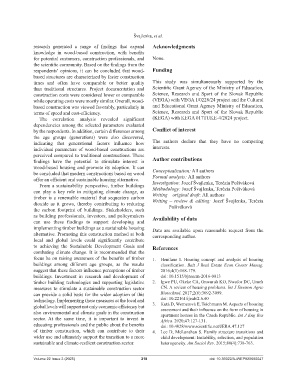Page 224 - AJWEP-v22i3
P. 224
Švajlenka, et al.
research generated a range of findings that expand Acknowledgments
knowledge in wood-based construction, with benefits
for potential customers, construction professionals, and None.
the scientific community. Based on the findings from the
respondents’ opinions, it can be concluded that wood- Funding
based structures are characterized by faster construction
times and often have comparable or better quality This study was simultaneously supported by the
than traditional structures. Project documentation and Scientific Grant Agency of the Ministry of Education,
construction costs were considered lower or comparable Science, Research and Sport of the Slovak Republic
while operating costs were mostly similar. Overall, wood- (VEGA) with VEGA 1/0228/24 project and the Cultural
based construction was viewed favorably, particularly in and Educational Grant Agency Ministry of Education,
terms of speed and cost-efficiency. Science, Research and Sport of the Slovak Republic
The correlation analysis revealed significant (KEGA) with KEGA 017TUKE-4/2024 project.
dependencies among the selected parameters evaluated
by the respondents. In addition, certain differences among Conflict of interest
the age groups (generations) were also discovered,
indicating that generational factors influence how The authors declare that they have no competing
individual parameters of wood-based constructions are interests.
perceived compared to traditional constructions. These
findings have the potential to stimulate interest in Author contributions
wood-based housing and promote its adoption. It can
be concluded that modern constructions based on wood Conceptualization: All authors
offer an efficient and sustainable housing alternative. Formal analysis: All authors
From a sustainability perspective, timber buildings Investigation: Jozef Švajlenka, Terézia Pošiváková
can play a key role in mitigating climate change, as Methodology: Jozef Švajlenka, Terézia Pošiváková
timber is a renewable material that sequesters carbon Writing – original draft: All authors
dioxide as it grows, thereby contributing to reducing Writing – review & editing: Jozef Švajlenka, Terézia
the carbon footprint of buildings. Stakeholders, such Pošiváková
as building professionals, investors, and policymakers Availability of data
can use these findings to support developing and
implementing timber buildings as a sustainable housing Data are available upon reasonable request from the
alternative. Promoting this construction method at both corresponding author.
local and global levels could significantly contribute
to achieving the Sustainable Development Goals and References
combating climate change. It is recommended that the
focus be on raising awareness of the benefits of timber 1. Henilane I. Housing concept and analysis of housing
buildings among different age groups, as the results classification. Balt J Real Estate Econ Constr Manag.
suggest that these factors influence perceptions of timber 2016;4(1):168-179.
buildings. Investment in research and development of doi: 10.1515/bjreecm-2016-0013
timber building technologies and supporting legislative 2. Igwe PU, Okeke CA, Onwurah KO, Nwafor DC, Umeh
measures to stimulate a sustainable construction sector CN. A review of housing problems. Int J Environ Agric
can provide a solid basis for the wider adoption of this Biotechnol. 2017;2(6):3092-3099.
technology. Implementing these measures at the local and doi: 10.22161/ijeab/2.6.40
global levels will support not only economic efficiency but 3. Kutá D, Wernerová E, Teichmann M. Aspects of housing
assessment and their influence on the form of housing in
also environmental and climate goals in the construction apartment houses in the Czech Republic. Int J Eng Res
sector. At the same time, it is important to invest in Africa. 2020;47:127-131.
educating professionals and the public about the benefits doi: 10.4028/www.scientific.net/JERA.47.127
of timber construction, which can contribute to their 4. Lee D, McLanahan S. Family structure transitions and
wider use and ultimately support the transition to a more child development: Instability, selection, and population
sustainable and climate-resilient construction sector. heterogeneity. Am Sociol Rev. 2015;80(4):738-763.
Volume 22 Issue 3 (2025) 218 doi: 10.36922/AJWEP025080047

